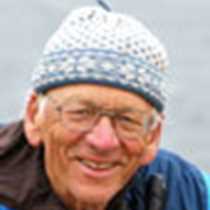Our exploration of the southern part of the Antarctic Peninsula ended during the night as we progressed back northward. Also during the somewhat dark night the weather changed. In the morning we were passing through ice that had been blown around from the bordering glaciers into Penola Strait. Huge icebergs of various shapes were accompanied by various sized companion ice floes and berg bits. The wind was biting from the north and snow flurries added to the very Antarctic conditions.
As we supercharged ourselves with a hearty breakfast, the captain positioned the ship close to the shores of the southside of Booth Island. A small sailboat was tucked in the lee of the island taking shelter from the winds. The plan for the morning was to go ashore where we would cross a snowfield to a high ridge where all three species of brush-tailed penguins could be seen. The program was similar to previous days as half of the group went ashore first while the remaining half on the ship were treated to a program by one of the staff naturalists.
Once on land we followed the path to the ridge where snow-free rocky outcrops provided nesting areas for the penguins. Even though it was breezy and a bit slippery everyone enjoyed the experience and the views of the surrounding landscape was spectacular. We all felt like real Antarctic explorers. Charcot, the early French explorer who overwintered in a small bay of Booth Island in the early 20th century would have been proud of our effort to view and experience the island.
During lunch the wind was slowly decreasing and the ship repositioned a few miles back southward to Peterman Island. Fortunately, the scouting party of naturalists were able to get through the dense ice that was drifting off the island to the protected landing area. And as the wind had lessened it was decided to offer Zodiac cruises and landings on the island. Snow patches still persisted on the land in areas but instead of being white they were tinted green and red from blooming growths of algae. Added penguin fertilizer invigorated the growth of the algae. As we enjoyed the landscape and being ashore, the ship maneuvered in the strait since it was far too deep to anchor. Light snow continued to fall and shroud the higher portions of the mountain peaks.
Later in the afternoon the Bridge steered the ship through the Lemaire Channel to a safe, protected anchorage for the night.







